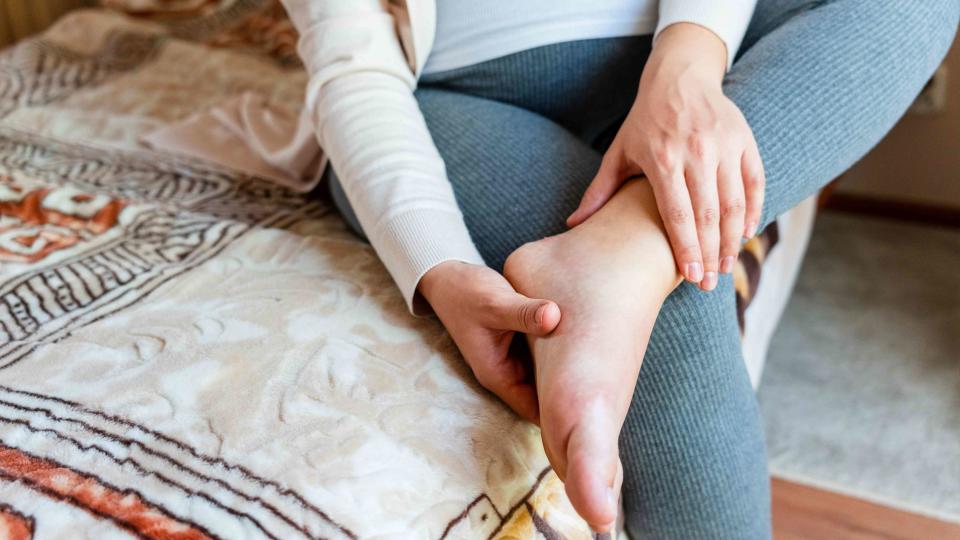3 Reasons You May Have Thick, Swollen Ankles
Learn common causes of wide ankles (aka cankles) — and diet and movement tips that may help reduce any swelling.

iStock / Getty Images Plus
The word "cankle" is a slang term used to describe thick or wide ankles. Although the term is cringe-worthy, for some people, developing thick ankles could be more than just a cosmetic concern. It could be a sign of less-than-healthy lifestyle habits (like a salty diet) or even indicate a serious medical issue, such as a heart problem.
Here, we dig into the causes of thick ankles and what can (and cannot) be done to get rid of them.
Related: The 10 Best Running Shoes for Beginners, Tested & Reviewed
What Are Cankles?
The term "cankle" is used to describe a thicker ankle that makes the lower calf and ankle appear blended together. The term was made popular in 2001 when Jason Alexander's character in the movie Shallow Hal used the term "cankle" to criticize a person's lower leg saying, "It's like the calf merged with the foot — cut out the middleman."
What Causes Cankles?
Cankles can be caused by simply having a wide or thick ankle due to your genes and anatomy. They can also appear thicker if you put on weight or if you develop a health condition. The reasons below are among the most common.
Edema
Edema is an abnormal swelling due to fluid buildup in the tissues. It can sometimes occur from lifestyle factors, such as a high-sodium diet or sitting or standing for long periods of time. It can also happen with injuries, chronic diseases, or even certain medical emergencies, like congestive heart failure and kidney disease.
Genetic Predisposition
Many people who have thick ankles are genetically predisposed to this type of lower leg, meaning that if one of your parents had larger ankles, you might have inherited them, too. This may be caused by obesity or the structural absence of a well-defined calf muscle — even if you are physically fit.
Fluid Retention
Fluid buildup in the ankle generally comes from a heavy sodium intake. It can be a reflection of one's sodium intake or the body's inability to rid itself of sodium, which can occur when someone has heart disease. It can also happen when standing or sitting for long periods of time.
If you notice that your ankles have begun to swell and/or feel as though you are retaining water, visit a healthcare provider. If you think diet is a factor, you can also schedule an appointment with a registered dietitian.
Related: 10 Foods to Reduce Bloating Symptoms So You Can Feel Better Fast
Pregnancy
My wife recently gave birth to our son Max, and I had the personal pleasure of witnessing the physical changes of a person during pregnancy. During those nine months, my wife's ankles swelled a great deal, which is quite common.
Extra fluid in the body during pregnancy and the pressure from the growing uterus can cause swelling in the ankles and feet. Swelling tends to get worse toward the end of pregnancy, especially toward the end of the day or on hot days.
To help minimize swelling, avoid high-sodium, processed, and fast foods. It's also important to drink plenty of water since your body will try to hold onto fluid when dehydrated. Massage and elevation also help with circulation and fluid retention.
When to Seek Urgent Medical Care
In some cases, swelling in your ankles, feet, and/or legs can indicate a serious medical condition, such as an infection, allergic reaction, blood clot, or heart or kidney failure. Seek urgent medical attention if you notice a sudden swelling, especially if it involves only one ankle and leg or if you have other symptoms or risk factors, such as:
Pain
Fever
Redness or warmth
History of heart, kidney, or liver disease
If either of the following symptoms accompany your ankle swelling, call 9-1-1 or a local emergency number:
Shortness of breath
Chest pain or pressure
If you are pregnant and have a sudden increase in swelling, contact your healthcare provider.
How to Reduce Ankle Swelling
If you're experiencing some minor fluid retention in your ankles during pregnancy or due to lifestyle factors, the following can help you reduce or get rid of cankles:
Prop up your feet when sitting and avoid crossing your legs
Stretch and move around often when sitting for long periods
While standing, move your feet and ankles around regularly
Drink plenty of water
Exercise regularly
Related: The Best Glass Water Bottles, According to Customer Reviewers
Best Exercises for Cankles
Although you can't change the shape of you ankles, well defined calves can make you ankles appear smaller or less prominent. To strengthen your calf muscles, the International Sports Sciences Association recommends the following exercises:
Calf Raises
Also any activity or workout that involves running and jumping can also help to tone the calves. Things like basketball, jogging, soccer, or a HIIT class that includes sprints and jumps all fit the bill.
Related: Why You Should Be Doing Calf Workouts—Plus One to Try
For more Shape news, make sure to sign up for our newsletter!
Read the original article on Shape.

